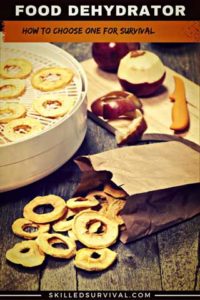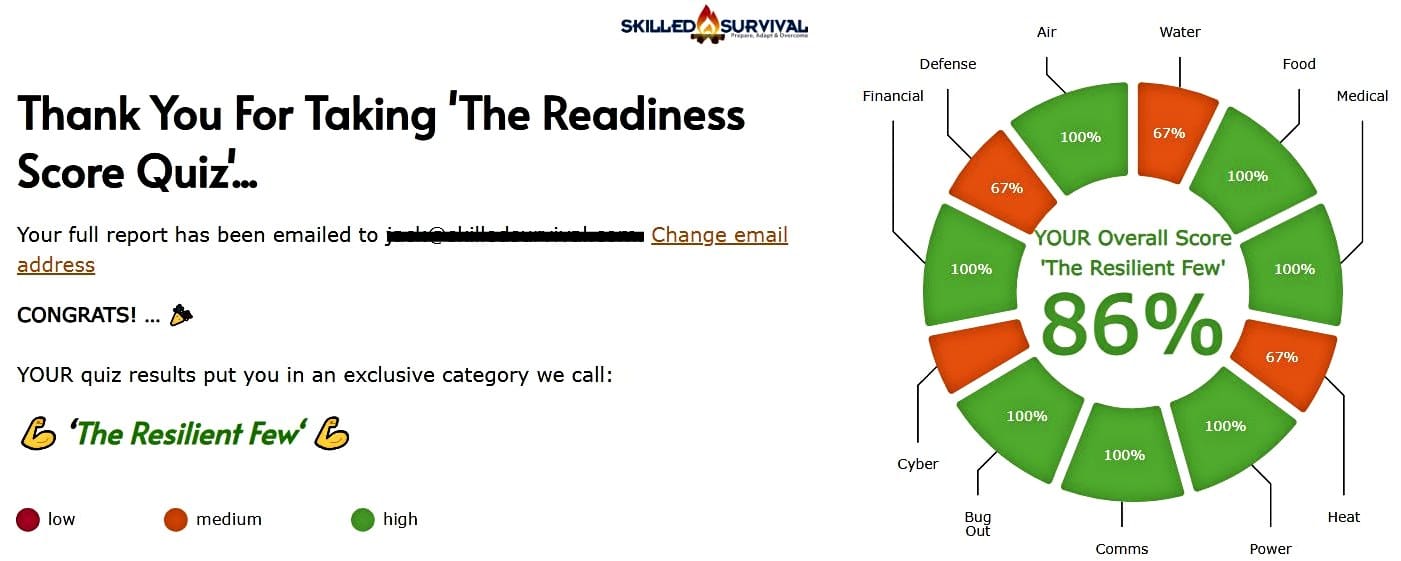
Because dehydrating food is the…
- Best
- Easiest
- Most affordable way
…to enjoy long-lasting, healthy snacks!
Not only that, but it’s a smart strategy for adding tasty emergency foods to your stockpile. But when it comes to dehydration, there’s a lot of misinformation out there.
This article will cut through the confusion and help you find the best method for your needs, so you can start preserving food like a pro.
Best Food Dehydrators For Sale Today
While using the sun or the wind to dehydrate your food is free, it’s not the most efficient method to dehydrate. Not anymore, at least. However, an electric dehydrator will speed up the drying process exponentially.
Plus, they ensure a much more consistent drying, hence better results.
They are simply the best way to dehydrate food, and tons of them are out there! No matter what size, style, or price you’re looking for, there’s one out there for you.
Here are the top dehydrators we tested on the market today:
This is our favorite and the dehydrator we recommend.
The Nesco Snackmaster Pro has a thermostat that allows you to dry different foods at the proper temperature for that food (95º-160º F).
It includes 600 watts of drying power due to its top-mounted fan.
The Nesco comes with 5 plastic trays, but you can also expand this unit with extra trays up to 12 total (trays are 13 1/2" in diameter).
Opaque exterior supports blocking light rays, which can destroy the nutritional content of food being dehydrated.
This unique drying system forces air down the exterior pressurized chamber (not through the trays). The heated air is forced horizontally across each tray, converging on the core for fast, even, and nutritious drying.
So there's no flavor mixing and no need to rotate trays.
An all-around excellent dehydrator. It's one of the most popular ones at a great price.
↓ The BEST Dehydrator! Nesco Professional Food and Jerky Dehydrator
↓ Drying Thyme With A Dehydrator (Gourmia GFD1950)
↓ Excalibur 3900 Tray Deluxe Heavy Duty Family Size Dehydrator
The Nutrichef is an easy-to-use dehydrator that does its job at the press of a button.
It comes with five removable dehydrator trays that stack vertically.
The Nutrichef Dehydrator is compact and fits comfortably on a countertop or table.
But because of its smaller size, you're limited on how much food you can dry at any given time.
↓ Nutrichef Dehydrator Review
↓ Cosori Dehydrator Unboxing and First Use
↓ Hanging Dehydrating Rack Review – Does It Work?
Why You Should Dehydrate Food
Dehydrating food is an ancient technique. One that’s still widely used around the world.
The earliest evidence of people doing it is from 12,000 BC! That means we have been drying snacks far longer than living in cities.
That’s how you know it’s such a practical survival skill.
It was practiced by people who survived in the ancient wild—hunters and gathers who wandered across barren, uncivilized lands.
But Why?
First, dehydrated food lasts a whole lot longer than fresh food. By drying it, you’re removing the moisture from food. Mold, yeast, and bacteria need water, oxygen, warmth, and food to grow.
So, by eliminating moisture from the equation, you’re helping to prevent food spoilage.
So, dehydrating food increases its shelf life exponentially. For example, a fresh banana from the store will last on a countertop for about a week. But if you slice up and dry that same banana into banana chips, it will keep for months (or even years).
And you’re retaining almost all its original nutritional value.
Dehydration is like stopping the food aging process!
This leads us to the second reason you should dehydrate food – dried foods are packed with nutrients.
Sure, potato chips last for a long time, too. But eating a lot of potato chips is bad compared to eating dried slices of fruits and veggies.
Foods you dehydrate – fruits, veggies, meats, etc. – keep most of their nutritional value.
That’s great news if you’re ever caught in an emergency and need nutrients but don’t have access to fresh foods.
With a healthy stock of dehydrated food, you will not have to worry. And last but not least, dehydrated foods taste great.
Something about sucking all the moisture out of things changes their flavor significantly.
It’s why dried mango chips don’t taste like fresh mangos, and beef jerky doesn’t taste like regular beef.
Dehydrating food is both smart for survival and a delicious everyday snack!
Any food that lasts is healthy, tastes good, and is a perfect survival food source. And dehydrating your food will save you money. It allows you to turn fresh foods into long-lasting survival snacks at an extremely low cost.
As we all know, buying large amounts of beef jerky, dried fruits, and fish from the store takes a small fortune.
It’s much better and easier on the budget to dry your foods using a food dehydrator.
↓ Benefits Of Dehydrating Foods

Want a free 78 item preppers checklist?
Enter your email below to instantly download this Complete Checklist PDF. No purchase necessary. 👇 👇How To Dehydrate Food
The easiest modern method for dehydrating your food is to use an electric dryer.
Our ancestors have been drying food for most of human history, long before electrical sockets and batteries existed.
↓ The Ultimate Dehydrator Guide
How Did They Do It?
Two main ways:
1. Using The Power Of The Sun
The first is still popular today – especially with tomatoes: sun drying.
It’s a straightforward process that begins with selecting good produce.
The best ingredients will make the best-dried produce.
Fruits should be cut into thin slices. And veggies (which have lower acid levels and spoil faster) should be cut into cubes or diced.
Spread your cut produce out on paper-lined trays or, better yet, cloth-covered wooden frames.
Protect the food from insects using cheesecloth.
Set the trays outside, and turn the food occasionally for even dehydration.
At night, bring the dried produce inside. And if rainy weather moves in, you can save your batch with some last-minute oven-drying.
Another conventional method for sun drying is to hang foods on a string, protected with cheesecloth or a screen.
The benefit of doing this is you do not have to turn the product as often as it dries.
Now, placing your food in direct sunlight or a shaded area will affect the finished product.
Most foods dried in the shade retain both color and flavor better. But it takes longer.
Food dried in direct sunlight will dry a lot faster.
Some recommend “pasteurizing” your dried food once it’s finished.
You can do this by popping it into the oven (at 175 degrees F)—ten minutes for veggies and fifteen for fruits.
↓ Homemade Solar Food Dryer: Simple Idea
2. Using The Power Of The Wind
The second method for drying food is wind drying.
Place the food slices on a mesh tray outside, letting the wind’s power suck out the moisture.
For this method to work, you need consistent wind. Luckily, dehydrating this way does not require hurricane-force winds. You can wind-dry your food inside with a fan.
Just place the trays or racks of goodies in front of the fan and let it sit. Chemistry will do the rest.
Storing Your Dehydrated Foods
After your food is dried out and ready to store, get some plastic bags.
Zip locks work, but the best option is to use a quality vacuum sealer to remove the air and moisture from the storage container.
Another option is to use mylar bags and oxygen absorbers to remove the oxygen after it’s sealed.
Always make sure your storage container is air-tight and void of moisture!
If any humidity gets locked in with the food, it will spoil.
There’s nothing worse than breaking into your survival food to discover that your dried snacks have gone bad when you need them most.
Best Food Dehydrator Features To Look For
Size And Capacity
If you’re a solo adventurer, a compact model might be perfect, while larger families or groups might benefit from a spacious dehydrator with multiple trays.
It’s all about efficiency and making the most of your drying sessions.
Temperature Control
Different foods require different drying temperatures. So having a dehydrator with adjustable heat settings allows you to tailor the drying process to each food item.
This ensures optimal preservation of nutrients and flavors, resulting in delicious, healthy treats.
Proper Airflow
Look for models with a fan located at the back, as it evenly distributes heat and air across all trays.
This prevents inconsistent drying and reduces the risk of spoilage, allowing you to store your dehydrated goodies for future use confidently.
Durability
Durability is paramount.
Seek out models with sturdy construction and quality materials that can withstand the challenges of high use.
Additionally, dishwasher-safe trays make for easy cleanup, which is always a bonus when you’re on the move.
Noise Level
Some dehydrators can be quite noisy, which might not be ideal for a peaceful home.
Opt for a quieter model to ensure a more enjoyable experience without disturbing the serenity of your surroundings.
Best Foods To Dehydrate
You can dehydrate a wide variety of foods. If it’s fresh and has moisture, you can probably dehydrate it.
That means fish, meat, fruits, and vegetables are all fair game. But the process is different for each, and for some foods, you can add spices for a little flavor boost.
↓ 10 Essential Dehydrated Foods You Need In Your Pantry!
Fruits
Apples, mangos, pears, bananas, plantains, tomatoes, grapes, peaches, oranges, dates, etc.
Dehydrating fruit takes, on average, 8-12 hours of dry time to reach full dehydration. And you should let them cool for about 60 minutes before packaging.
This allows any excess moisture to evaporate.
Some people spice their apples with cinnamon sugar before placing them in the dryer.
This sweetens up an already delectable treat. The same can be done for any fruit before dehydration and packaging.
You can also use any excess fruit from your garden and turn it into fruit purees to make fruit leather (sometimes called a fruit roll).
Vegetables
Broccoli, cauliflower, celery, carrots, corn, peas, potatoes, etc. As with fruits, veggies take about 8-12 hours to dehydrate fully and should be given an hour to cool.
With veggies, you can get creative with your spices as well.
To spice things up, add chili powder, cayenne pepper, onion powder, garlic salt, or black pepper.
Meats
Pork, beef, venison, rabbit, turkey, chicken, pheasant, etc.
Meats take longer than anything else to dehydrate because of the texture of the flesh. Depending on the thickness and type, allow 6-24 hours for meat. Don’t be afraid to try different kinds of spices to alter the flavors of your meat.
Dried salted pork is a popular favorite. But you can also rub venison or beef in a red chili rub or a garlic-lime infusion.
Also, don’t forget about making your own beef jerky.
↓ How To Make Beef Jerky With A Dehydrator
The key to making great jerky is using a stainless steel jerky gun! And don’t forget about your furry friends – you can also make fantastic dry meat dog treats with a dehydrator!
Another way to preserve meat is by making pemmican (a 50-plus year superfood).
You should try our pemmican recipe if you’ve never heard of it.
Fish
Freshwater fish, saltwater fish, shellfish, cephalopods, etc.
Fish lands between veggies, fruits, and meats on the dry-time scale. Fish should be left to dry between 10-15 hours. Wind drying is popular with fish because there are often consistent winds near oceans and lakes.
You should add salt to help dry your fish. And not just for flavor’s sake but also because it adds extra preservative qualities to the meat.
Salting fish doubles down on the preservative power of your dehydration process.
Bread
Survival bread, survival crackers, hardtack. These are all names for a simple, dry, dense bread that will last decades if you prepare, dry, and store it properly.

Want a free family-first food planning guide?
Enter your email below to instantly download this Complete Guide PDF. No purchase necessary. 👇 👇How To Maintain Your Food Dehydrator
Just like any other kitchen appliance, dehydrators need regular maintenance. Luckily, most modern dehydrators make this easy.
The most significant thing to watch out for is shelf cleanliness.
After each dry, remove all the shelves and wash them to remove any leftover food particles. For some dehydrators, this is easier than for others.
That’s why you should look for washable shelves when shopping for a dehydrator. Otherwise, you’ll be doing most of the cleanup by hand.
It’s also good to scrub the inside of your dehydrator after a few uses.
Drying foods can leave a slight residue on the inside of your dehydrator that builds up over time.
If left for long enough, the residue could change the flavors of future foods you dry.
For example: Your dehydrated fish might get a fruity smell. Or your dried veggies might develop a fishy taste. No one wants that!
The solution is easy: once every three or so uses, thoroughly scrub the inside of your dehydrator.
↓ Easy & Frugal Way To Clean Your Dehydrator
Final Thoughts
Stocking up on non-perishable survival food for emergencies or disasters is an absolute must. But some survival foods don’t taste all that great. And many of them lack the necessary nutrients to survive a dangerous situation.
Dehydrated foods offer a tasty, healthy, long-lasting way around that problem.
It allows you to preserve the food you grew, foraged for, caught, or hunted yourself.
Knowing how to use the wind and the sun is useful in survival. But having your modern electric dryer is even better.
It speeds up the process and makes for more consistent, reliable results.
Invest in a food dehydrator and start stocking up! It’s so easy.
Start drying every week and build your food stockpile of dehydrated foods that will grow. And when disaster strikes, you will be thankful to have all that tasty dried food at your fingertips.

Prepare, Adapt & Overcome,
P.s. - I just found out 2 out of 3 Americans don’t feel prepared for a 3 day disaster!!!
I guess this goes to show how modern society continues to embrace ‘living a fragile life.’ What’s crazy is… it’s so easy to fix.
To make sure YOU have the basics, watch our FREE training on “10 Simple Steps To Basic Preparedness” that shows you HOW.
Nothing crazy here… this isn’t doomsday prepping... just the basics every responsible adult should have before a disaster strikes.Why You Can Trust Skilled Survival...
Go here now to review a full breakdown of:
- Who We Are
- Our Credentials
- Our Mission
- & Product Recommendations...
Here are a few highlights of our teams credentials & certifications:
- Certified Member of a Mountain Search & Rescue Organization
- Plant Emergency & Safety Leader for a Major Food Manufacturer
- Member of the 10TH Mountain Division Hut Association
- Certifications: Avalanche 1, WFR, CPR
- Official Gear Tester for Numerous Outdoor Gear Companies
- Countless Multiday Backpacking trips into Remote Wilderness
- Bachelor's Degree In Mechanical Engineering
- Bachelor's Degree In Civil Engineering
- Bachelor's Degree In Biomedical Engineering
"It takes 20 years to build a reputation and five minutes to ruin it." - Warren Buffett
We're fully aware that trust is NOT something you GET but is EARNED.
And we'll continue to earn YOUR trust through our forthright and honest approach with each new Blog Post, Guide & Product we create...
P.s - I just took this FREE 60-second 'Readiness Score Quiz'👇
AND... I've still got a few gaps in my preps...🤔 But at least, I'm not part of 'The Fragile Masses'. 👍 Find out where YOU stand by answering a few questions...

Recommended Reading
Emergency Food Storage When Calories Become Scarce
Building your emergency food storage doesn't have to be complicated. We break things down into simple steps to help you do it right.
The Most Nutritious Survival Foods You’ll Actually Love
What are the best survival foods? It depends on your goals. We look at different scenarios to help you stockpile the best emergency foods.
Dehydrating Fruit: How To Preserve Sweet Calories
Dehydrating fruit is a great way to store tasty calories for long-term storage. We should you the best way to dehydrate some for emergencies.
Unique Food Storage Ideas: The Most Surprising Locations
Want a large emergency food stockpile but living in cramped quarters? Don't let this ruin your preparedness passion! Try these unique food storage ideas.
Prepper Food: Best Ones to Stockpile For Emergencies
What's the worst-case scenario if you choose NOT to stockpile any food? Starvation. That's why investing in prepper food is so wise.
Valley Food Storage Review: An Expert Puts It To The Test
Unbiased and thorough Valley Food Storage review covering food supplies, packaging, taste, and shelf life. Don't buy without reading this...













